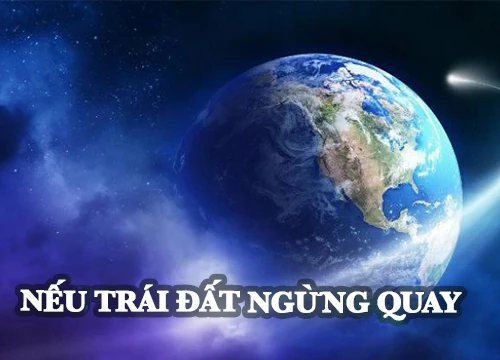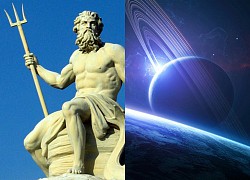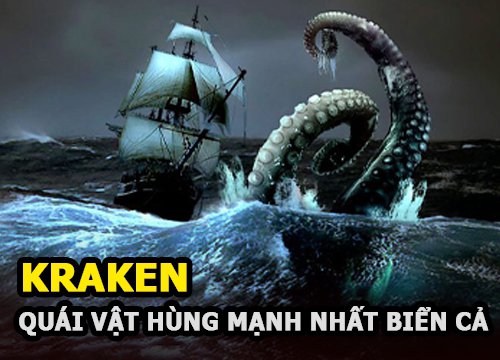What would happen to humanity if the Earth stopped rotating?

5 | 0 Discuss | Share
The Moon always moves in a fixed orbit, while maintaining a relatively safe distance from the Earth.
But if this limit is broken, what will happen?
If the distance from the Earth to the Moon is reduced to only half of what it is now, a lot of strange phenomena and natural disasters will come to our planet and cause serious consequences.
Tide
In Jim Carrey's 2003 film Bruce Almighty, Carrey's character is unexpectedly powerful. He used that power to pull the Moon closer to the Earth in order to attract his beloved. Later, also in the film, background footage shows television news reports of unprecedented floods around the world.
The scenario outlined by Neil Comins, a physicist at the University of Maine, is also not very different from what happens in the movie.
According to him, if the distance between the moon and the earth was only half of what it is today, the tide level would be eight times higher.
This is because of the Moon's gravitational pull on the Earth's oceans, which has a direct effect on the daily rise and fall of the tides.
The obvious consequence is that a series of islands will be completely submerged in sea water. Meanwhile, densely populated coastal areas may not be able to live due to high tides.
It is clear that a person having the power to pull the Moon closer to the Earth is very unrealistic. However, many people also wonder what would happen if the distance between the Earth and the Moon was reduced to only half of what it is today.
Earthquake
However, higher tides are not the only effect of the Moon being closer to Earth. Comins said the Moon also has an impact on the terrestrial part of the Earth. "If the distance between the Moon and Earth were to be half of what it is now, the result would be energy waves bouncing across our planet due to the Moon's sudden increase in gravity," he said.
"That gravity will actually impact the Earth's crust, which means it could cause more earthquakes, possibly trigger more volcanic eruptions" - Jazmin Scarlett, historian and socialite Volcanology Society at Queen Mary College, London.
For example, Jupiter's Moon Io is home to the most volcanoes in the Solar System. The volcanoes here are the result of the push and pull from the gravity of Jupiter and two of its other Moons. Earth could meet a similar fate if the Moon suddenly gets closer to us.
Along with that, the sudden change of the planet's crust will cause the Earth's rotation to slow down over time. This is because as the Moon's gravity pulls the oceans, the friction between the ocean floor and the water slows the Earth's rotation. Today, the Earth's rotation slows down by about 1 millisecond per century. If the distance between the Earth and the Moon were reduced to only 1/2 of what it is now, the Earth's rotation would slow down even more.
If we survive sudden earthquakes, volcanic eruptions, higher tides, then humans will see eclipses more often. Because the Moon will cover a larger area of the sky and it will have more chances of passing in front of the sun from our perspective.
The above talk about the case where the distance from the Moon to the Earth suddenly decreased by half compared to the present. So what happens when the Moon slowly spirals toward Earth?
Days and nights are longer
According to Jazmin Scarlett, in that case, the Earth's crust and the planet's tides would shift gradually, and that's the hope of allowing life to adjust to the changes.
Besides a series of natural disasters such as earthquakes, volcanoes, tsunamis... we can also feel the change of space and time more clearly if the distance from the Earth to the Moon is only half.
Accordingly, the sudden change of the planet's crust can cause the Earth's rotation to slow down over time.
This happens when the Moon's gravity acts on the oceans, causing friction between the ocean floor and the water to slow Earth's rotation.
It is estimated that the Earth's rotation tends to slow down by about 1 millisecond per century. However, the distance between the Earth and the Moon is reduced to only 1/2 of what it is now, the Earth's rotation will be slower than that, making the day and night longer.
This will directly impact the climate on Earth in a way no one could have foreseen, while also prompting evolutionary changes in many different directions.
For example, animals will have to adapt to learn to hide better at night because the bright Moon will make them more visible to predators.
Phenomena like solar eclipses will also occur more frequently, as the Moon will have more of a chance to pass in front of the Sun from an Earth's perspective.
So now that the Moon is so far away from the earth, why are there still tides?
The Moon is the closest celestial body to Earth in the universe. The average distance between the Moon and Earth is 384,400km. If man walked from the Earth to the Moon, it would take about 9 years. If you take a spaceship, it takes more than 7 days to go back from Earth to the moon every time.
The mutual attraction between the Moon and the Earth tends to bring them closer together. But this attraction is compensated by the centrifugal rotation of the Earth, as well as that of the Moon, around their centers of inertia.
At the center of the Earth, the centrifugal force and the gravitational force from the Moon complement each other. But this is not the case at some point on the earth because the two forces change in opposite directions: the farther a point is from the center of gravity of the Earth - the Moon, the greater the centrifugal force it will experience, in when in reverse, the Moon's gravity decreases with distance.
Thus, the two forces do not compensate each other on the surface of the Earth, and their difference is the source of the tides: at point A, the centrifugal force is not enough to balance the attraction, so A tends to shift. move towards the Moon. In contrast, at point B the centrifugal force is greater than that of the Moon, so B tends to move away from it. That's why on Earth there are two tides per day.
This differential suction affects the entire surface of the Earth, but only the deformation of the ocean is noticeable, and the Earth's crust is so solid that its shape is difficult to change. This distortion increases when the Sun is aligned with the Moon and Earth, which in turn adds its own tidal effect. Therefore, at the time of the new moon and full moon, the tides are strongest.
Daily, there are 2 high tides and 2 low tides. Each day the tides appear about 1 hour later than the previous day. Because every day, the Moon has to make part of its rotation around the Earth, so the Moon is 1 hour different to return to the exact same point.
Tide boundaries (the difference in sea level at high tide and low tide) vary widely. In oceans, this amplitude is 1m, in closed and small seas it is less: about 30cm, but in estuaries and straits it can be up to 17m.
Interesting facts about tides
The Earth revolves around itself in 24 hours and the moon takes 27.3 days to orbit the Earth. Wherever you are on earth, after 24 hours, you have to wait for the moon to move for another 50 minutes before you see it again in a position directly above your head.
During both the new moon phases (dark, the moon is between the earth and the sun and is backlit by the sun) and the full moon (the brightest, the earth is between the moon and the sun), gravity on the earth Earth is the highest, equal to the sum of the effects of the sun and the moon. This explains why the tide phenomenon has 2 peak times: the new moon appears and the full moon day.
When the moon is in the phases of crescent (visible) and crescent (), the gravitational pull of the sun and moon on earth will form a 45 degree angle. When this total force is at its highest, the earth is somewhere between the moon and the sun.
The time it takes for the earth to move to this position can be several hours faster or slower than when the moon is highest in the sky. So the highest tides will occur before or after the moon is highest in the sky.
Low tide is the weakest tide, occurs when the moon is in the first or last (visible) phase or quarter, when the gravitational pull of the sun and moon on the earth forms a 90 degree angle, so are almost completely mutually exclusive.
Tides are sometimes more difficult to predict because the moon does not orbit the earth directly at the equator, but its orbit is tilted at an angle of 5 degrees relative to the plane in which the earth orbits the sun. Earth's self-revolving orbit is also tilted 23.5 degrees from this plane, creating different seasons.
So the highest tides for each day will always be above or below the equator. That's why the tides only rise once a day in high tide areas.
Neptune and the truth about the farthest "ice giant" in the solar system  Hồng Hạnh18:40:37 04/07/2021The coldest planet in the Solar System, has an eternal storm about the size of Earth and is the smallest gas planet just a few of the interesting facts about Neptune. It will not be easy if you want to see Neptune with your own eyes. This object is located about 4.41 billion...
Hồng Hạnh18:40:37 04/07/2021The coldest planet in the Solar System, has an eternal storm about the size of Earth and is the smallest gas planet just a few of the interesting facts about Neptune. It will not be easy if you want to see Neptune with your own eyes. This object is located about 4.41 billion...

5 | 0 Discuss | Share

3 | 0 Discuss | Share

5 | 0 Discuss | Share

6 | 0 Discuss | Share

1 | 0 Discuss | Share

5 | 0 Discuss | Share

2 | 0 Discuss | Share

1 | 0 Discuss | Share

5 | 0 Discuss | Share

1 | 0 Discuss | Share

1 | 0 Discuss | Share

5 | 0 Discuss | Share










2 | 0 Discuss | Report